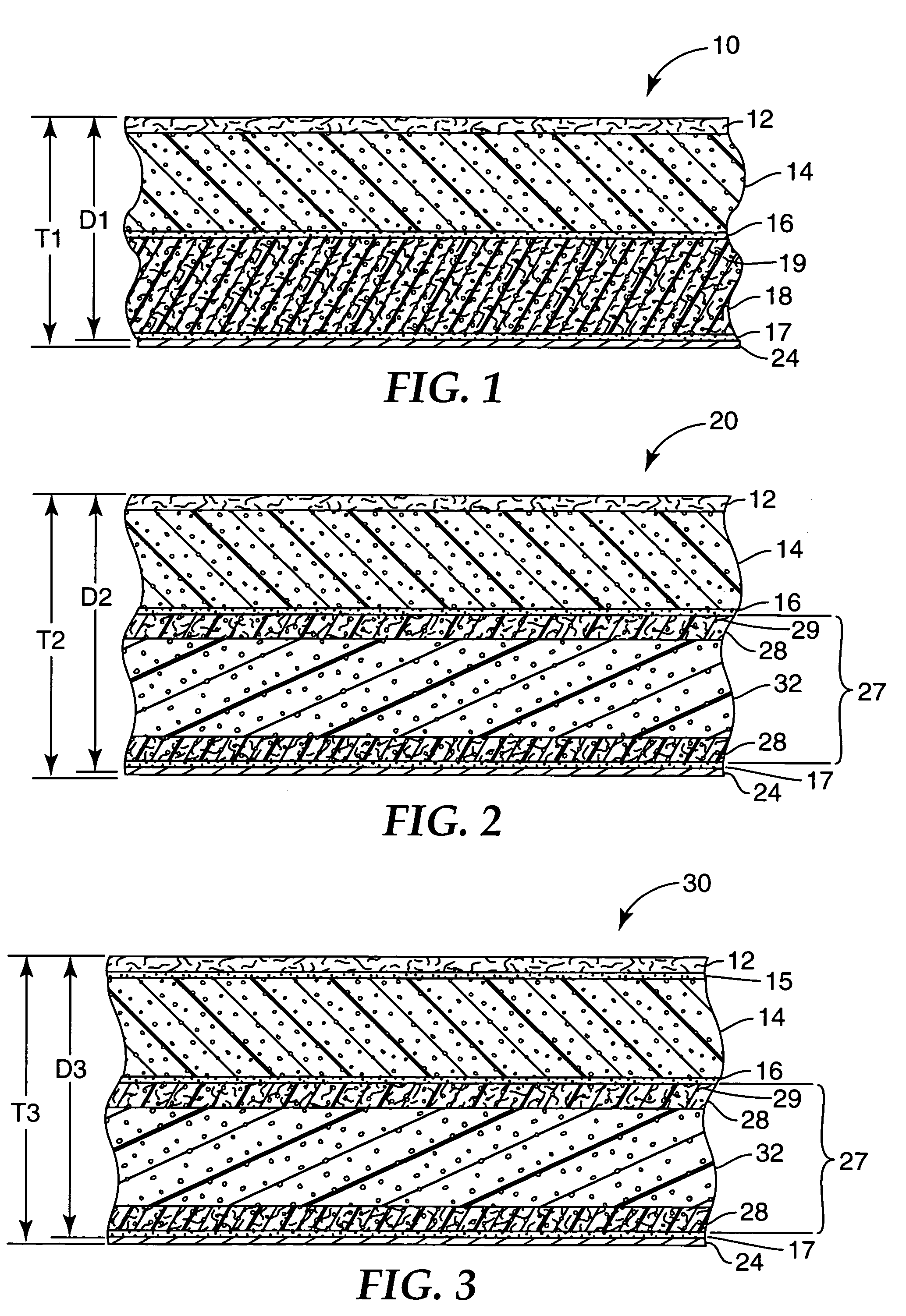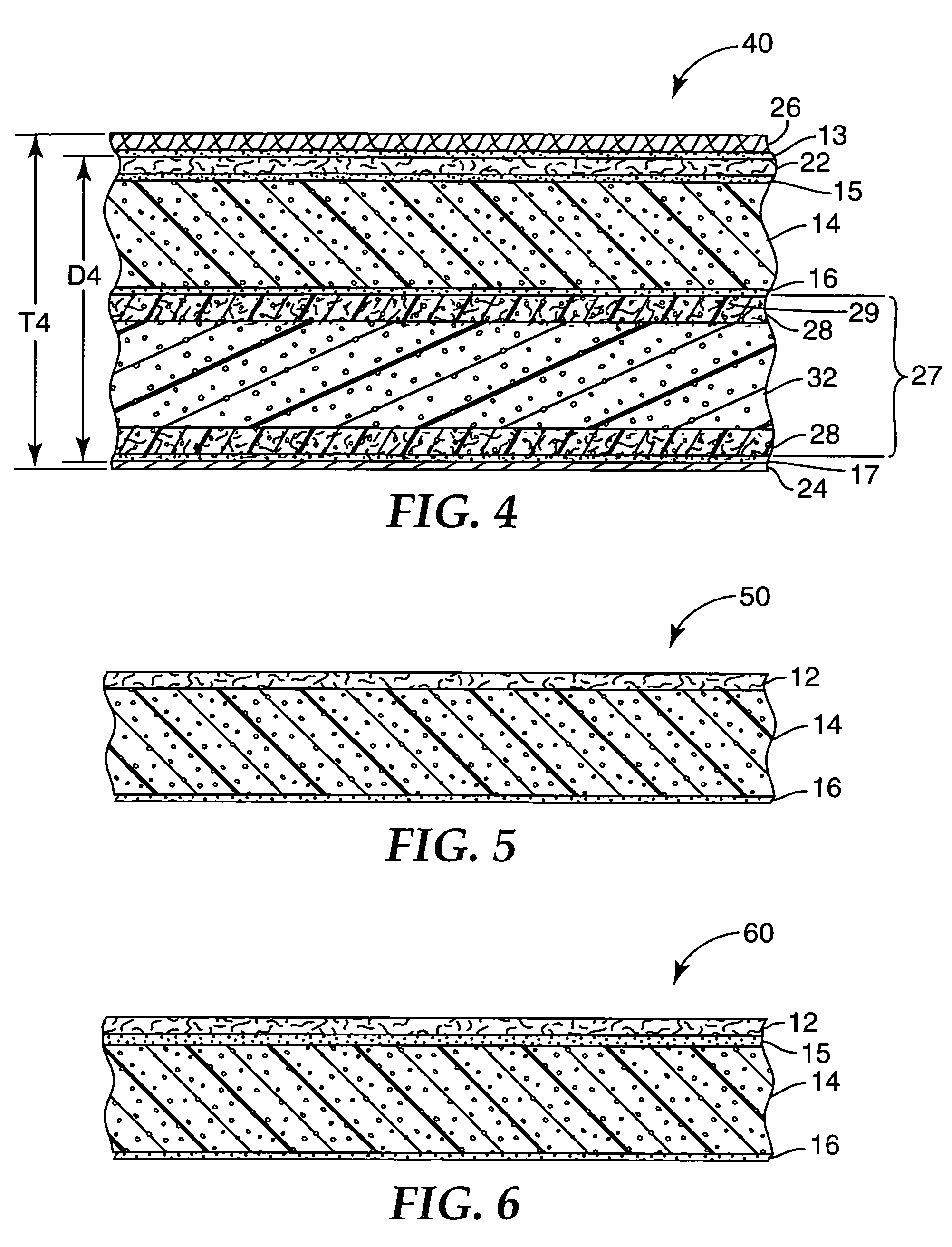Sound absorptive multilayer composite
a multi-layer composite and sound absorption technology, applied in the direction of synthetic resin layered products, flooring, building components, etc., can solve the problems of suboptimal design acoustic performance and achieve low additional thickness or weight penalties, improve acoustic performance, and reduce vehicular interior noise levels.
- Summary
- Abstract
- Description
- Claims
- Application Information
AI Technical Summary
Benefits of technology
Problems solved by technology
Method used
Image
Examples
example 2
[0059]The Example 1 composite facing fabric layer was lightly coated with another misted layer of spray adhesive and covered with a second layer of the semipermeable airflow-resistive membrane employed in Example 1. Acoustically, the result was like using a single, more airflow-resistive membrane. The resulting sound absorptive multilayer composite had a structure like composite 80 shown in FIG. 8. Adhesive layer 9 had a negligible thickness. The composite had an 11.7 mm cavity depth and an 12.3 mm total composite thickness, or a 95% ratio of cavity depth to total composite thickness. This composite was identified as Example 2 and evaluated for sound absorption at normal incidence using the method of Example 1. The sound absorption results are shown as Curve 2 in FIG. 9, and demonstrate that a further improvement in sound absorption could be obtained at lower frequencies by using a more airflow-resistive membrane.
example 3
[0060]A composite was prepared by swapping the locations of the semipermeable airflow-resistive membrane (membrane 12 in FIG. 7) and the open cell foam layer (foam 14 in FIG. 7) in the Example 1 composite so that the semipermeable airflow-resistive membrane was buried beneath the foam layer and thus further from the occupant side. A light mist coat of spray adhesive was used to reassemble the layers. The resulting composite was evaluated for sound absorption at normal incidence using the method of Example 1. This composite had a lower sound absorption coefficient (viz., poorer performance) than the Example 1 composite at all measured frequencies. The results are shown below in Table 1:
[0061]
TABLE 1Absorption Coefficient,Absorption Coefficient,Composite with MembraneFrequency, HzExample 1 Compositeand Foam Layers Reversed1000.020.0121250.020.0021600.040.0312000.060.0422500.080.0583150.1 0.0714000.120.0925000.160.1246300.2 0.1758000.270.2581k0.350.33 1.25k0.440.3831.6k0.520.4212k0.6 0...
example 4
[0063]A second sample of the European luxury sport utility vehicle automotive headliner evaluated in Comparison Example M was obtained from the vehicle manufacturer. The entire facing fabric layer was carefully removed, measured to determine that it had an airflow resistance well below 100 mks Rayls, and discarded. The exposed open cell foam layer was lightly coated with a misted layer of spray adhesive and covered with the semipermeable airflow-resistive membrane employed in Example 1. A hot air gun was used to remove wrinkles. The completed headliner was identified as Example 4 and shipped back to the vehicle manufacturer for an in-vehicle noise comparison to the original equipment headliner. The noise comparison test was performed on a smooth surface track at 112 kilometers per hour, using a microphone placed near the driver's right ear. The results are shown in FIG. 11 as a plot of sound pressure level (SPL) vs. frequency. Curve M shows the original equipment noise level and cur...
PUM
| Property | Measurement | Unit |
|---|---|---|
| thickness | aaaaa | aaaaa |
| total thickness | aaaaa | aaaaa |
| total thickness | aaaaa | aaaaa |
Abstract
Description
Claims
Application Information
 Login to View More
Login to View More - R&D
- Intellectual Property
- Life Sciences
- Materials
- Tech Scout
- Unparalleled Data Quality
- Higher Quality Content
- 60% Fewer Hallucinations
Browse by: Latest US Patents, China's latest patents, Technical Efficacy Thesaurus, Application Domain, Technology Topic, Popular Technical Reports.
© 2025 PatSnap. All rights reserved.Legal|Privacy policy|Modern Slavery Act Transparency Statement|Sitemap|About US| Contact US: help@patsnap.com



